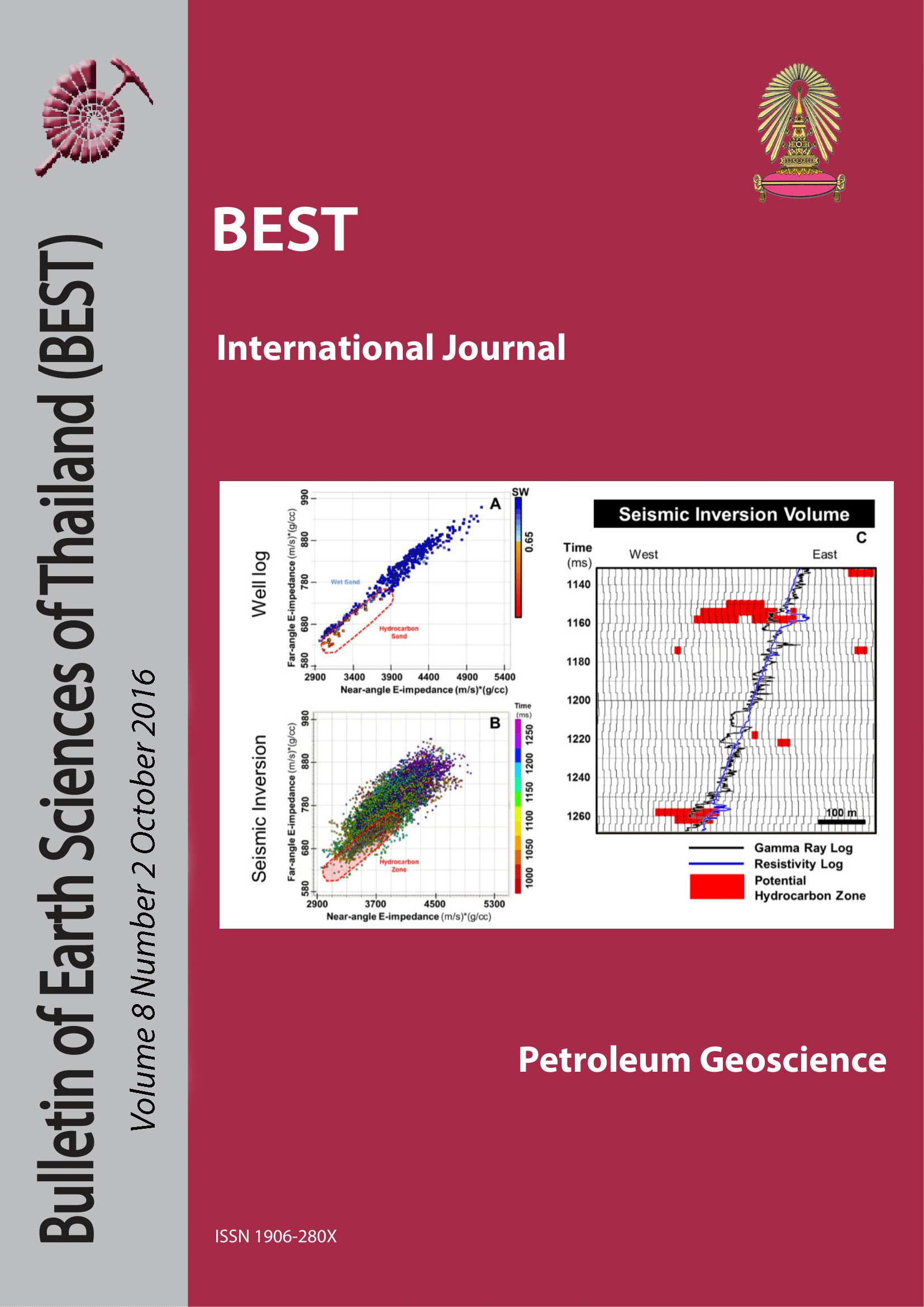RESERVOIR CHARACTERIZATION USING FAR ELASTIC IMPEDANCE IN NORTHWESTERN PATTANI BA
Main Article Content
Abstract
Imaging reservoir distribution in the Pattani Basin, Gulf of Thailand is important and challenging. Due to the nature of the fluvial depositional environment, the reservoir is extremely compartmentalized by rapid lateral stratigraphic changes as well as intense normal faulting which is influenced by the regional tectonics of this area. The elastic impedance technique has been applied in order to exploit the amplitude variation with offset (AVO) information. The AVO informa-tion can provide a better lithology discrimination than acoustic impedance in this area. Eight well log data were used along with partial-angle stacked seismic data, especially far-angle stacked seismic data. Three main approaches have been applied in this study which are rock physics analysis, seismic inversion and seismic attribute technique. Crossplot analysis reveals that far elastic impedance (EI) provides the best lithology discrimination as well as the density log. P-impedance can also be used for lithology discrimination down to approximately 2,000 meters. Below 2,000 meters, the P-impedance from sand and shale lithologies begin to overlap. Fluid-bearing types are still difficult to differenti-ate by using rock physics analysis due to their overlapping zones. Accordingly, far EI inversion has been generated in order to extrapolate far EI value away from wells. The result of inversion shows a reasonable predicted far EI value at both inversion and blind-test wells. Moreover, multiple seismic attributes have been applied over the inversion result in order to improve the visualization of reservoir distribution. Results of seismic attributes against drilled well data show a correlation between a very low impedance and hydrocarbon sands and also successful imaging of reservoir distribution. The study results prove that applying these approaches can be used to distinguish reservoir section from other lithologies. The reservoir images can be used to predict reservoir distribution to reduce the exploration and development risks.
Article Details

This work is licensed under a Creative Commons Attribution-NonCommercial-NoDerivatives 4.0 International License.
Copyright © 2008 Department of Geology, Faculty of Science, Chulalongkorn University. Parts of an article can be photocopied or reproduced without prior written permission from the author(s), but due acknowledgments should be stated or cited accordingly.
References
Ahmad, M. N. and Rowell, P., 2013, Mapping of fluvial sand systems using rock physics analysis and simultaneous inversion for density: case study from Gulf of Thailand: First break, v. 31, May 2013, p. 49-54.
Connolly, P., 1999. Elastic impedance: The Leading Edge, v. 18, p. 438-452.
Jardine, E., 1997, Dual Petroleum Systems Governing The Prolific Pattani Basin Offshore Thailand: Proceedings of the Petroleum Systems of SE Asia and Australasia Conference, May 1997, p. 351-363.
Morley, C.K., and Racey, A., 2011, Tertiary stratigraphy, in M.F. Ridd, A.J. Barber, and M.J. Crow, eds., The geology of Thailand: Geological Society of London, p. 223-271.
Punglusamee, K., 2014, AVO Feasibility study for hydrocarbon detection in northwestern of the Pattani basin, Gulf of Thailand: M.Sc. thesis, Chulalongkorn University, 67 p.
Simm, R., and Bacon, M., 2014, Seismic Amplitude: An Interpreter’s Handbook, New York, Cambridge University Press, 271 p.
Veekan, P.C.H., and Da Silva, M., 2004, Seismic inversion methods and some of their constraints: First break, v. 22, June 2004, p. 47-70.
Wutthijuk, P., 2015, Elastic impedance study in RIP area, Gulf of Thailand: M.Sc. thesis, Chulalongkorn University, 45 p.


